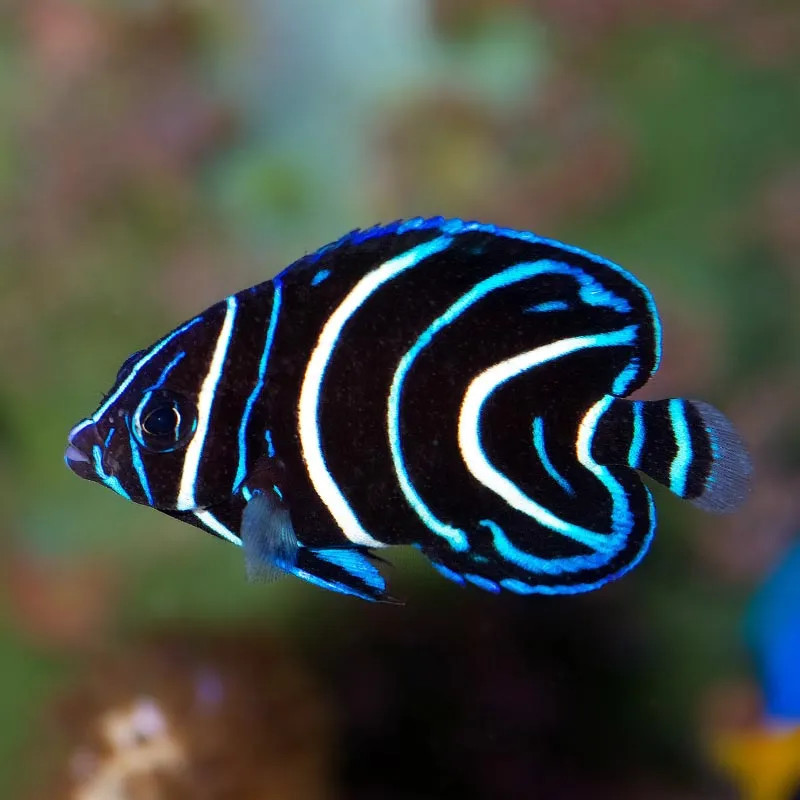Stocks Available
Blue Ring Angelfish - Small Adult
SKU:210865

Stock Available
Introduction: • Species: Koran Angelfish • Common Names: Koran Angelfish, Semicircle Angelfish, Blue Koran Angelfish • Natural Habitat: Found in coral-rich lagoons and outer reef slopes in the Indo-Pacific region, from East Africa to Australia, including the Red Sea. Physical Characteristics: • Appearance: Juveniles have striking electric blue and white semicircular stripes, while adults develop a greenish-blue body with yellow accents and a marbled pattern. • Size: Can grow up to 15 inches (38 cm) in the wild, though typically smaller in captivity. • Lifespan: With proper care, Koran Angelfish can live up to 20 years in captivity. Habitat Requirements: • Tank Size: Requires a minimum of 180 gallons due to its large size and active nature. • Water Conditions: o Temperature: Prefer water temperatures of 72-82°F (22-28°C). o pH: Maintain a pH level of 8.1-8.4. o Salinity: Salinity levels between 1.023-1.025. • Aquascaping: Provide plenty of live rock for grazing and hiding places to mimic its natural reef habitat. Diet: • Primary Diet: Omnivorous; in the wild, it feeds on sponges, algae, tunicates, and small invertebrates. • Supplemental Feeding: In captivity, offer a varied diet of high-quality marine angelfish foods, including spirulina, marine algae, mysis shrimp, and sponge-based preparations. • Feeding Frequency: Feed 2-3 times daily to ensure it receives enough nutrients. Compatibility: • Temperament: Generally semi-aggressive, especially as it matures. It can be territorial, particularly toward other angelfish and similarly shaped species. • Suitable Tank Mates: Compatible with larger, non-aggressive fish like tangs, wrasses, and other large species. Avoid housing with smaller, timid fish. • Incompatibilities: Avoid keeping with other angelfish unless the tank is very large, as they may fight over territory. Care Level: • Difficulty: Moderate to advanced; requires a stable, well-maintained environment with excellent water quality and a varied diet. • Health Monitoring: Monitor for signs of disease, such as ich, bacterial infections, or HLLE (Head and Lateral Line Erosion), which can affect angelfish in suboptimal conditions. Breeding: • Breeding in Captivity: Very difficult to breed in captivity due to size and behavior. Koran Angelfish are egg scatterers, and spawning generally occurs in the open water. • Spawning: In the wild, males court females and release eggs that float in the water column. Larvae are planktonic and require specific care to develop. Economic Considerations: • Market Demand: High demand in the marine aquarium trade due to its striking appearance, particularly the dramatic change from juvenile to adult coloration. • Wholesale Pricing: Juveniles tend to be priced lower due to their smaller size and availability, while adults command higher prices. • Retail Pricing: Koran Angelfish are typically in the moderate to high price range, depending on size and health. Sustainability and Conservation: • Wild Population: Generally stable, though some regions face habitat destruction due to reef damage. • Aquaculture Efforts: Limited success in captive breeding; most Koran Angelfish in the trade are wild-caught. • Regulations: Ensure compliance with local and international laws concerning the trade of marine species, especially from protected reef areas. Conclusion: The Koran Angelfish is a visually striking and popular species in the marine aquarium trade, known for its dramatic juvenile-to-adult transformation. While requiring a large tank and advanced care, it offers long-term beauty and interest for experienced marine hobbyists. With proper attention to its dietary needs and water quality, the Koran Angelfish can thrive in captivity for many years, making it a rewarding addition to a well-maintained marine aquarium.
Data sheet
16 other products in the same category:
Customers who bought this product also bought: